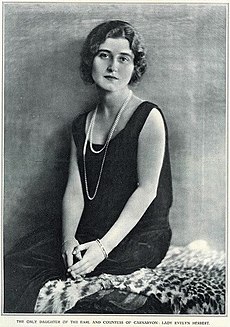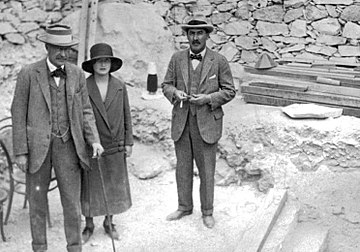Evelyn Beauchamp
Lady Evelyn Leonora Almina Beauchamp (née Herbert; 15 August 1901 – 31 January 1980) was the daughter of George Herbert, 5th Earl of Carnarvon. In November 1922, she, her father and the archaeologist Howard Carter were the first people in modern times to enter both the tomb and inner burial chamber of the Egyptian Pharaoh Tutankhamun. She later married Sir Brograve Beauchamp and had a daughter. Lady Evelyn died in 1980, at the age of 78.
Evelyn Beauchamp | |
|---|---|
 Lady Evelyn in 1923 | |
| Born | Evelyn Leonora Almina Herbert 15 August 1901 Highclere Castle, Hampshire, England |
| Died | 31 January 1980 (aged 78) London, England |
| Nationality | British |
| Known for | Present at the opening of Tutankhamun's tomb |
| Spouse(s) | |
| Children | One daughter |
Early life
Lady Evelyn Leonora Almina Herbert was born on 15 August 1901, the second child and only daughter of George Herbert, 5th Earl of Carnarvon and Almina Herbert, Countess of Carnarvon.[1] Her older brother was Henry Herbert, 6th Earl of Carnarvon.
While seldom in the company of her parents as a child, Evelyn grew closer to her father as she grew older.[2] From 1920, she accompanied him on his annual visit to Egypt.[3] Journeying to Egypt in January 1923, the journalist Valentine Williams noted "the tender friendship" between father and daughter that was "delightful to watch",[4] while Howard Carter referred to Evelyn as her father's "devoted companion in all his Egyptian work".[5]
Lady Evelyn was launched as a debutante and presented at court in 1920,[6] with her mother staging receptions for her, including at the British Residency in Cairo during their Egyptian stays in 1921 and 1922. It was during one of these receptions that she met her future husband, Brograve Beauchamp, the son of the Liberal MP Sir Edward Beauchamp, who continued to visit her when they both returned to England.[7][8]

Tutankhamun's Tomb
Lord and Lady Carnarvon often spent the winter in Egypt, where they bought antiquities for their collection in England. In 1906 Lord Carnarvon obtained a concession to excavate a site near Luxor, and later one within the Valley of the Kings.[10] From 1907, Lord Carnarvon employed Howard Carter to supervise the excavation work.[11] By 1922 little of significance had been found and Lord Carnarvon decided this would be the final year he would fund the work.[12]
However on 4 November 1922, Carter was able to send a telegram to Lord Carnarvon, in England at the time, saying:
"At last have made wonderful discovery in Valley; a magnificent tomb with seals intact; re-covered same for your arrival; congratulations".[10]
Lady Evelyn accompanied her father, and by 24 November 1922 both had arrived in Egypt and were present when the full extent of the stairway to the tomb was cleared and a seal containing the Pharaoh Tutankhamun’s cartouche was found over the doorway. This door was opened and the rubble filled corridor behind cleared, revealing the door to the main tomb.[10] This door, and the main tomb, were to be officially opened under the supervision of the Egyptian Department of Antiquities on 29 November. However on the 26th and 27th, Carter, his assistant Arthur Callender, Lord Carnarvon and Lady Evelyn made one or more unauthorised visits inside the tomb,[13][14] becoming the first people in modern times to enter it. Callender rigged up electric lighting, illuminating a jumble of items, including gilded couches, chests, thrones, and shrines. They also found two more sealed doorways, including one to the inner burial chamber,[15] guarded by two life-size statues of Tutankhamun. A small hole was found in this doorway and Carter, Carnarvon and Lady Evelyn crawled through it into the inner burial chamber.[10] The diary of Lord Carnarvon’s half-brother Mervyn Herbert,[16] although not a first-hand account, notes that Evelyn, being the smallest of the party, was the first person to enter the burial chamber.[17]
Lady Evelyn and her father travelled to England in December 1922, the two returning in January 1923 to be present at the official opening of the inner burial chamber on 16 February.[18] The same month Brograve Beauchamp visited with his parents, Howard Carter providing a tour of Tutankhamun’s Tomb.[8] Soon afterwards Lord Carnarvon contracted blood poisoning and died in Cairo on 5 April 1923.[19] Lady Evelyn left Egypt to return to England with her brother, Lady Carnarvon following with Lord Carnarvon's remains a week later.[18] This was Evelyn's last visit to Egypt. She did, however, maintain contact with Howard Carter[20] and was present at his funeral at Putney Vale Cemetery in 1939.[21]
Lady Evelyn attended the opening of the Tutankhamun 50th anniversary celebrations in 1972, including the Treasures of Tutankhamun exhibition at the British Museum, London, where she was presented to the Queen who was there to open the exhibition.[22]
Marriage and later life
_grave_Putney_Vale_2019.jpg)
On 8 October 1923, Lady Evelyn Herbert married Brograve Beauchamp[1] at St Margaret's Church, Westminster.[23] They had one child, Patricia Evelyn Beauchamp (11 July 1925 – 7 October 2014).[24]
Brograve became a baronet on the death of his father in February 1925. He served as Conservative Member of Parliament for Walthamstow East from 1931 to 1945,[25] and died 25 August 1976 at the age of 79.[1]
Like her father and brother, Lady Evelyn owned a number of racehorses and often attended race meetings, being described in the press as "petite, charming and immensely popular in racing circles".[26] She was also closely involved in London Society and regularly appeared in Society publications like The Tatler.[27] In July 1935 she was involved in a serious car accident on her way to Newmarket, Suffolk,[28] recuperating in the London nursing home established by her mother during the First World War.[29] She later suffered from a number of strokes.[30]
Lady Evelyn died in London on 31 January 1980 aged 78,[31] three years after Sir Brograve.[16] She is buried beside her husband in Putney Vale Cemetery in South West London.[32][33] Howard Carter is also buried at Putney Vale.[34]
Relationship with Howard Carter
Lady Evelyn had known Howard Carter since she was a child, with Carter often visiting the Carnarvons' homes in London and Hampshire.[35] From 1920, Evelyn began to accompany her father on his annual winter trips to Egypt,[36] where she and Carter were on friendly terms.[37] While there were later suggestions of a discreet romantic relationship between the two, there is no evidence of any rumour or gossip among those present at the time.[38] Lady Evelyn denied the idea, later telling her daughter Patricia that "at first I was in awe of him, later I was rather frightened of him", she resenting Carter's "determination" to come between her and her father.[39] More recently, the 8th Earl of Carnarvon dismissed the story, describing Carter as a "stoical loner".[40]
In popular culture
Lady Evelyn Herbert has been portrayed in both films and television productions, with events portrayed with varying degrees of accuracy:[41]
- By Angharad Rees in the 1980 Columbia Pictures Television production The Curse of King Tut's Tomb.[42]
- By Alexandra Weaver in the 2005 BBC TV docudrama series Egypt, episodes one The Search for Tutankhamun, and two The Curse of Tutankhamun.[43]
- By Amy Wren in the 2016 British ITV series Tutankhamun.[44]
- In The Mummy the character Evelyn Carnahan is named in tribute to Lady Evelyn Carnarvon,[44] whose father is described as one of Egyptology's "finest patrons", and a "famous explorer".
The German language novel Der König von Luxor by Philipp Vandenberg published in 2014[45] includes a largely fictionalised Lady Evelyn Beauchamp as one of the three principal characters.[46]
Notes and references
- "Burke's Peerage".
- Winstone 2006, p. 343.
- Cross 2006, p. 49.
- Winstone 2006, p. 186.
- Winstone 2006, p. 142.
- The Tatler, Wednesday 14 April 1920, pages: 2-4.
- Cross 2006, pp. 48-49.
- "Lady Evelyn Herbert : Debutante of 1920".
- Harry Burton’s photos of Tutankhamun’s Tomb, Griffith Institute Archive.
- Price 2007, pp. 119-128.
- Winstone 2006, p. 95.
- Carnarvon, Fiona (2011). Highclere Castle. Highclere Enterprises. p. 59.
- "Howard Carter's diary entry for 25-27 November 1922".
- Reeves 1990, p. 63.
- "Howard Carter's diaries 28 Oct-31 Dec 1922".
- "Burke's Peerage, 2003 page 699".
- Hoving 1978, p. 129.
- "Howard Carter's diaries 1 Jan- 31 May 1923".
- "Report of Carnarvon's death". New York Times. 5 April 1923. Retrieved 12 August 2008.
- "For example, Evelyn was the first person Carter visited on a 1923 trip to London, see his diary 30 May".
- Winstone 2006, p. 327.
- Cross 2006, p. 55.
- Illustrated London News, Saturday 13 October 1923, page 6.
- "Burke's Peerage, 1970 page 206".
- Craig, F. W. S. (1983) [1969]. British Parliamentary Election Results 1918–1949 (3rd ed.). Parliamentary Research Services. p. 468. ISBN 0-900178-06-X.
- The Sketch, Wednesday 7 April 1937, pages: 20–21.
- For example: The Tatler, Wednesday 11 August 1943, pages: 10, 11, 26.
- Liverpool Echo, Wednesday 3 July 1935, page: 13.
- Portsmouth Evening News, Thursday 4 July 1935, page: 6.
- Cross 2006, p. 77.
- Entry on findagrave.com
- Putney Vale Cemetery: Burial and cremation records
- "Confirmed by photograph of graves".
- Cross 2006, p. 97.
- Cross 2006, p. 52.
- Winstone 2006, pp. 342-343.
- Winstone 2006, p. 135.
- Cross 2006, p. 74.
- Winstone 2006, p. 321.
- Furness, Hannah (14 October 2016). "Row over Tutankhamun's tomb affair as ITV drama brings discovery to life". The Telegraph. Retrieved 24 April 2020.
- Winstone 2006, p. viii.
- "The Guardian 22 July 2012 Angharad Rees obituary". Retrieved 6 November 2018.
- "BBC Genome: The Curse of Tutankhamun, 2005". Retrieved 6 November 2018.
- "Radio Times.com 23 Nov 2016 Did Howard Carter and Evelyn Carnarvon have a romantic relationship?". Retrieved 14 January 2018.
- "Catalogue of the Deutschen National Bibliothek". Retrieved 14 January 2018.
- "Bastei Luebbe, Publisher". Retrieved 14 January 2018.
Sources
- Cross, William (2006). Carnarvon, Carter and Tutankhamun Revisited: The Hidden Truths and Doomed Relationships. The author. ISBN 1-905914-36-9.CS1 maint: ref=harv (link)
- Hoving, Thomas (1978). Tutankhamun: The Untold Story. London: Cooper Square Publishing. ISBN 9780815411864.CS1 maint: ref=harv (link)
- Price, Bill (2007). Tutankhamun, Egypt's Most Famous Pharaoh. Pocket Essentials, Hertfordshire. ISBN 1842432400.CS1 maint: ref=harv (link)
- Reeves, C N (1990). Howard Carter before Tutankhamun. London: Kegan Paul. ISBN 0810931869.CS1 maint: ref=harv (link)
- Winstone, H.V.F. (2006). Howard Carter and the discovery of the tomb of Tutankhamun. Barzan, Manchester. ISBN 1-905521-04-9.CS1 maint: ref=harv (link)